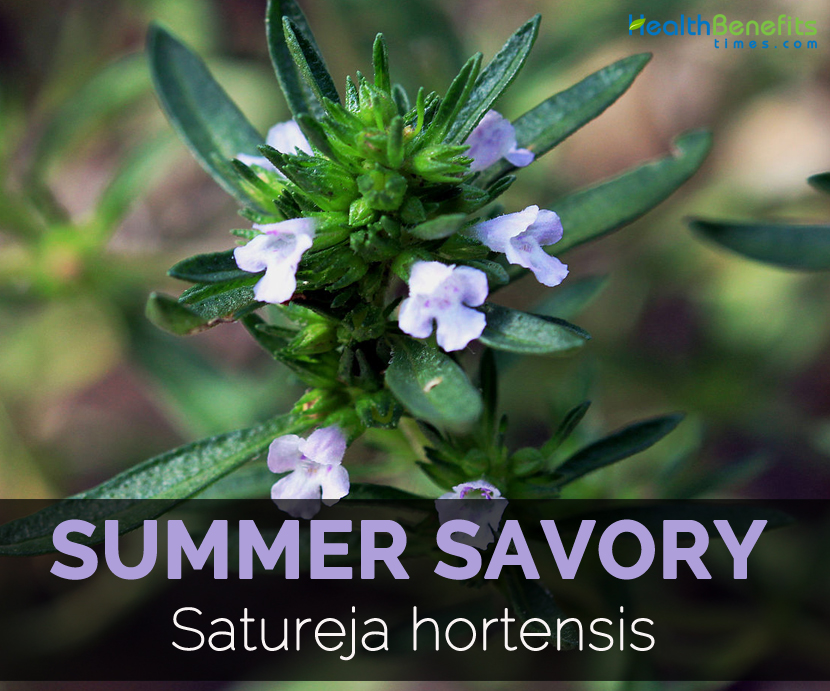| Summer savory Quick Facts | |
|---|---|
| Name: | Summer savory |
| Scientific Name: | Satureja hortensis |
The plant blooms lilac tubular flowers found usually from July to September. It grows to the height of 30 to 60 cm (0.98 to 1.97 ft) and has slender and bronze to green leaves. Stems are branched having very short retrorse white hairs. Leaves are linear-lanceolate, about 10-20 x 1-3 mm which tapers into inconspicuous petiole and gland dotted having simple hairs. Calyx is bilabiate and 3-5 mm having simple hairs; teeth is narrow liner to subulate, apiculate. Corolla is pink or white about 5-10 mm. Nutlets are pale brown, oblong to ovoid and about 1 to 1.4 mm long.
Health Benefits of Summer Savory
- Leaves have carvacrol and thymol. Thymol combats against various bacterial strains such as Bacillus cerus and E. coli. Thymol has antiseptic and antifungal properties that protect the body from various fungal infections.
- Leaves and tender shoots have antioxidant property, that lowers oxidative damage in the body. It lowers bad cholesterol and promotes good cholesterol.
- The essential oil has anti-inflammatory properties that soothe joint pain by lowering inflammation from joints. Also lowers swelling and tenderness in muscles.
- It has linalool, tannins, carvacrol and cymol which are beneficial to treat intestinal disorder such as cramps, indigestion, bloating, gas, nausea, diarrhea and loss of appetite.
- The aphrodisiac property is used to increase libido.
- Tea prepared from leaves is used for treating internal health problems and prevent urine retention, uterine contraction and colic.
- The herb treats sore throat, wounds and skin infection.
- Dry savory has vitamin B6 or pyridoxine that maintains GABA (soothing neurotransmitter) levels in the brain having stress buster function.
- Vitamin C develops resistance against infectious agents and eliminates harmful and pro-inflammatory free radicals.
- Vitamin A is an antioxidant and fat soluble vitamin which maintains healthy mucosa and skin.
- Summer savory helps to combat infections.
- It promotes the secretion of gastric juices that provides relief from various digestive problems such as bloating and flatulence.
Culinary uses
- Leaves are cooked or also consumed raw.
- Its aromatic, slightly peppery flavor makes it perfect for cooked foods such as beans.
- Also it is used as a garnish for salads.
- Leaves are used fresh or dried.
- Leaves are used to make herbal tea.
- Add it to stuffings, sausages and pork pies.
- It is also boiled with dried pea to make pea soup.
- Use it as a substitute for chervil and parsley.
- It is used as a seasoning for barbecues and grilled meats.
Medicinal uses
- Take the herb internally as a cure for colic and flatulence. Also it is helpful for diarrhea, nausea, sore throat, bronchial congestion and menstrual disorders.
- The external use of the ointment made from plant provides relief from arthritic joints.
- It is used as a tonic for gastro-intestinal disorders such as nausea, cramps, diarrhea and indigestion.
- The essential oil is used as an ingredient in lotions for scalp for treating baldness.
Precautions
Not to be prescribed for pregnant women.
References:
https://www.itis.gov/servlet/SingleRpt/SingleRpt?search_topic=TSN&search_value=32308#null
https://pfaf.org/user/Plant.aspx?LatinName=Satureja+hortensis
https://en.wikipedia.org/wiki/Summer_savory
http://www.efloras.org/florataxon.aspx?flora_id=5&taxon_id=220012015
http://www.naturalmedicinalherbs.net/herbs/s/satureja-hortensis=summer-savory.php
Comments
comments
